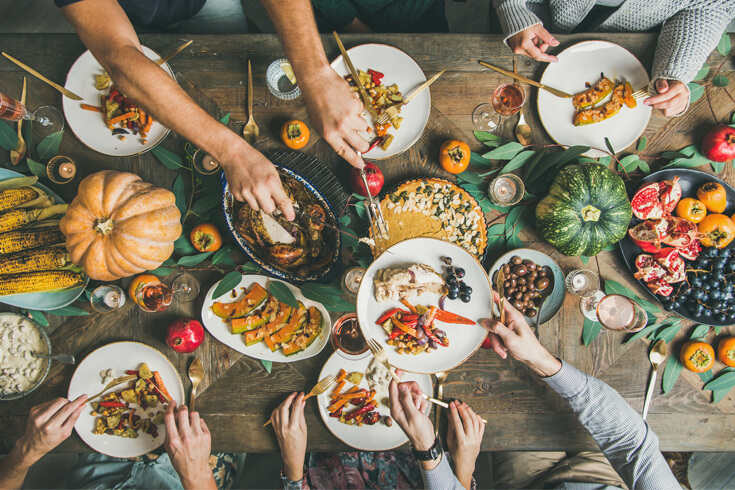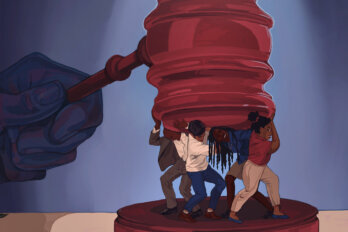It began with butter, a surreal amount of butter, glistening with tiny pinpricks of fat. It was studded with fragments of fresh herbs and whipped nearly to a foam. There was bread as well, but it was a supporting character. It, too, was excellent, a dark rye loosely stacked in rough slices on the right-hand side of a plate-size slab of black lava rock. The butter was mounded up on the left side, a lump the size of a Christmas orange, melting gently where it lounged against the warm stone slab. The stone itself was of the same sort found in the walls of the restaurant and rimming the pool of steaming azure water outside the window. This stone played hide-and-seek among the drifting snow from here to Reykjavík. I took a moment to gaze out on the falling flakes and on the tall blond bathers revelling in the shimmering water. Some perched on the rocks, and others floated in the pool’s volcanic embrace. I’d spent the morning there, and after the meal and perhaps a short period of digestion, I would return. But, for now, there was butter.
I plucked another slice of bread from the slab and spread it liberally with butter. The fresh herbs, tiny leaves, and twigs I couldn’t recognize gave off the smell of a summer mountaintop. My grandmother liked butter, I thought to myself, my mind rambling in the manner of the solitary diner. My grandmother would have approved of this excess.
I was in Iceland to study the food of hard places. I had copious notes from my fieldwork in Newfoundland as a comparison, full of tales of cod tongues, salt pork for Sunday dinner, and seal flipper pie. Now here was another island on the ragged northern edge of the world, full of friendly people, tidy settlements, and interesting cuisine. Iceland—conveniently located between the December gloom of London, where I had just been, and the December gloom of Vancouver, where I needed to be—is awash in interesting food. I talked to restauranteurs in the snow and dark. I visited thermal greenhouses in the snow and dark. I chatted with ice-eyed fisherman in the snow and dark next to an ocean of such a forbidding temperament I couldn’t turn my back on it.
I loved it. The noonday sun barely graced the horizon long enough to cast a glow on the mountains across the ice-choked harbour. I enjoyed tasting everything I could get my hands on, prowling the streets like a hungry wraith of midwinter. I ate fish as fresh and delicate as snowflakes. I did end up nibbling the fermented shark meat I’d been warned about and regretted it for several hours as the smell and taste hung on me like a pungent ghost. I munched on lichen. I tossed back salads grown with the heat of volcanos and ate bread cooked in the ground. I ate a great quantity of skyr, the yogurt that is really a cheese made from the milk of the Icelandic cattle descended from cows brought from Norway in the tenth century. They are now a distinct product of their harsh home, small in stature and few in number, with only 30,000 lactating cows working to fill the breakfast bowls of Iceland. They are unusual cows, their coats pied or brindled in six colors, as plush as cats. They are tended on 700 farms that tuck into fertile valleys along the coast, where they eat the local vegetation in small plots of pasture, isolated for a millennium from the rest of cattle kind. The Icelandic cow is different, and its milk—extremely high in protein and low in fat—passes that difference along to the sort of butter one can eat by the spoonful.
The world has found Iceland. Tourists flood the streets of Reykjavík. Skyr, so rich and wonderful, is an increasingly prized export in a food-obsessed world. So prized, in fact, that the cows of Iceland cannot possibly keep up with demand. A possible solution would be to crossbreed Icelandic and Norwegian cows to increase production per acre, but in the process, the purebred Icelandic cow would likely go extinct from introduced disease and genetic mixing. There is no real way to make the magical cloud of butter brooding on a slab of volcanic rock available to a wider audience without making it into a pale copy of itself. That butter emerged from centuries of harsh landscape and slow cattle-breeding combined with skilled preparation. To lose the butter of Iceland, and the foods like it, would be a great loss.
Many of the unique foods that help to make the world a diverse and interesting place are in danger. The forces of globalization, industrialization, and ecological collapse threaten the wealth of culinary products that make our cultures distinct. Some of these foods are becoming rare, some are becoming much more expensive, and some face outright extinction. Some have already become extinct.
To understand these threats, imagine a feast. It can be any feast: a Las Vegas buffet, a family holiday dinner, a South Pacific pit BBQ, or an Indonesian rijsttafel, the classic meal of many small dishes served for special occasions. Imagine a meal with many dishes and more food than can possibly be eaten at once. There are two things in that feast, aside from a great deal of hidden labour. There are dozens, if not hundreds, of species of plants and animals, a sort of culinary menagerie. There is also a huge body of culinary knowledge, the accumulated knowledge of growing, harvesting, processing, and preparing foods, handed down and improved upon over generations. A feast is a bit like a book, but a tasty book we read through eating. Now imagine that the dishes start to disappear one by one. The raspberries for the waffles, the sage on the Thanksgiving turkey, the poi or the pisang goreng. Gone. Slowly the table becomes less interesting, less captivating, and as each species disappears, the accompanying cultural knowledge vanishes with it.
This is the paradox of the lost feast. Even as we enjoy a time in which food is cheaper, more diverse, and more available than ever before, the spectre of extinction threatens to radically challenge how we eat. In fact, it is already happening.
Butter is an old innovation. When one milks a cow, the cream separates to the top as a liquid filled with microscopic globules of butterfat that are protected by a membrane. When we agitate cream, we introduce air to the mix, forming a colloid better known as whipped cream. But, as any overenthusiastic cook knows, beating the cream further forms something new: butter. Unbeknownst to most, they have ruptured the membrane that has kept the fat in suspension, releasing it into its new form.
Humans figured this out as early as 6500 BCE, leaving a buttery residue as evidence on ancient pottery. By 2500 BCE, the Sumerians were crafting tablets illustrating the preparation of butter from cow’s milk, a durable if heavy instruction manual. Butter spoils quickly in hot climates, forcing the development of other innovations. They were adding salt to their butter to extend its shelf life by Roman times, and in India, they discovered that one can remove the solids to create a much more lasting substance, known as ghee. In northern Europe and the United Kingdom, butter was packed into firkins and stored in bogs, where it became rancid but remained edible for a very long time. Occasionally, we still dig up the odd forgotten barrel.
The making of butter is such an important culinary innovation because it takes a product with a very short shelf life, milk, and turns it into a product that lasts longer and is easier to transport. And, of course, we like butter. We like the taste and we like its texture. It’s both rich and satisfying, and in the world of cuisine, satisfying matters. We need food to stay alive; we embrace cuisine out of enjoyment.
Lately, people who love food have been sharing a growing sense of concern. Farmers shaken by floods and droughts talk to me about the changing climate and the challenge posed by increasingly unpredictable weather. Fishers talk of declining stocks and unpredictable prices shaped by international markets. Wild foragers tell me of shrinking habitats and vanishing ecosystems. There is a sense of urgency, the sense that the hour is growing late. Our diverse food systems are increasingly under threat.
Cuisine is a language. Languages have two central properties, and the language of food is no different. Primarily, a language allows us to communicate, permitting us to pass on what we have learned to future generations and to other groups of humans, no matter how remote. Through language, we can trade important messages about food. Where to find it, how to prepare it, and where in the forest we might want to be on guard for hungry leopards while we forage. However, each language is also a unique way of looking at the world, a point of view influenced by place and time. Each language contains concepts that do not translate easily, and if a language is lost, those ways of seeing the world are lost too. The French idea of terroir is a good example of this. The term translates very roughly as “the taste of the landscape” and suggests the character of a food is intrinsically local. Terroir is shaped by climate, soil, growing techniques, and processing traditions, creating foods linked to a specific land and people. Cuisines have terroir, bringing together ecology and culture to tell a story of what it is to be human. In Canada, for example, we occasionally cook with snow, using the sap of the sugar maples found only in eastern North America. (Prairie muffin recipes and tire d’érable, maple taffy, are the best examples but are certainly not the only way Canadians use snow in cooking.) Oaxaca, Mexico, is famous for its seven moles, Singapore for its chicken rice. The Scottish have their magical whiskeys imbued with brooding peatlands, smelling of wind, long train rides, cozy pubs, and winter nights spent reading gothic novels. Some foods are so local that they tell the story of a single valley, river, or mountain range.
If we lose our cuisine, we lose a part of ourselves. And oh, such parts. The “words” of the culinary language are ingredients, and the overwhelming bulk of our ingredients break down into species, though multiple ingredients can come from a single biological source. The complexity of each specific dish has developed over time. Our most fleeting and ethereal meal draws on the experience of centuries. There is, however, still a lot to learn. We are clever at exploiting our environment, yet the potential riches of the world’s biosphere are vastly greater than what we currently consume.
Plants provide the bulk of our calories, and of the roughly 400,000 plant species on earth, some 300,000 are potentially edible. Yet we have domesticated and farmed only a few hundred of these plants, and the vast majority of our calories come from just three: corn, rice, and wheat. This might seem like a shocking lack of imagination, but domesticating a plant takes a lot of work and time. The wild ancestors of many of our most popular food species would be almost unrecognizable to us. Along with our domesticated species, we eat a few thousand wild foods that are harvested regionally, but most edible species are still largely unknown.
Our animal-protein choices are equally limited. We have a wide variety of foods available from the 65,000 species or so in the chordates: fish, mammals, amphibians, reptiles, and birds. Yet only fifty or so are domesticated and farmed regularly, and the bulk of animal protein comes from chickens, cows, pigs, and ducks. But we can eat almost all of the chordates with a few shockingly poisonous exceptions. The same can be said of the invertebrates. We love lobster and toss back a smattering of species such as snails and sea urchins, but we don’t even know how many invertebrates there are on earth. We certainly haven’t tasted them all.
Extinction is a part of the natural world. For each million species on earth, about one species goes extinct per year. As there are about 10,000 known edible species on earth, in a balanced ecosystem we would expect one culinary species to go extinct each century. However, they experience a special stressor: predation by humans. Historically, culinary species have suffered an extinction rate roughly five times as high as the background rate. Each of these lost species can teach us an important lesson about today’s global food system. And each also shines light on an ecological vulnerability threatening our planet’s plant and animal life. Our ecosystems are not in balance, and the loss of food species is almost certain to grow.
The story of life is most often written as survival of the fittest, but the overwhelming reality for most species is a quick expiry doled out to evolution’s runners-up. Each ecological niche shapes species, favouring random mutations that give certain individuals the slightest of reproductive edges. Over time, these mutations gather to the point of divergence, and a new species adapted to ecology, climate, and other species thrives. However, adaptation isn’t guaranteed, and when climate shifts too rapidly, or an ecological niche is destroyed, or a species is outcompeted, extinction is a grim probability.
As Elizabeth Kolbert explores in detail in The Sixth Extinction, at least five major extinction events have rocked the earth over the last billion years or so. The most shocking, at the end of the Permian, involved a huge release of carbon dioxide that eliminated as much as 90 percent of the life on earth. More worryingly, she argues, we are now in the midst of a sixth such event, this one driven by human activity.
The story of the lost feast is the story of an element of the earth’s sixth mass extinction event, an extinction that is unfolding now. This extinction is being called the Holocene event, after the geological epoch in which human civilization arose. Unlike the other great extinctions, this one is ongoing, and we have an active part to play in determining whether this event is a minor one or a major series of losses that mark the geological record for eons to come. The driver of the Holocene extinction is human activity, and the current rate of extinction is estimated to be roughly 100 times the background rate.
The Holocene extinction began with the loss of the large land animals, the megafauna, and it continues with the loss of species in almost every ecosystem on earth. The food system is linked to the Holocene extinction at almost every step—we’ve overexploited wild stocks, expanded our farmland and grazing land relentlessly, and introduced exotic species wherever we have settled. E. O. Wilson suggests that by 2100, one-half of earth’s species will be gone if today’s rate of extinction continues. Somewhere between 7 and 10 percent of our era’s species have been lost already.
Adapted from Lost Feast: Culinary Extinction and the Future of Food by Lenore Newman. © by Lenore Newman. Published by ECW Press Ltd.





